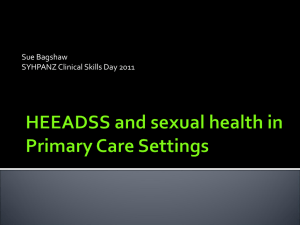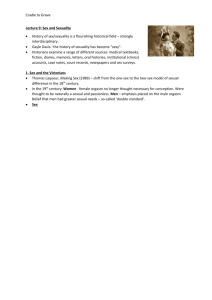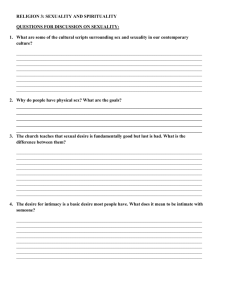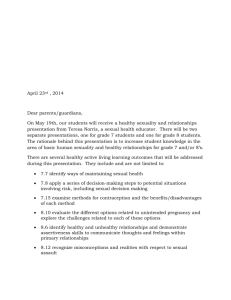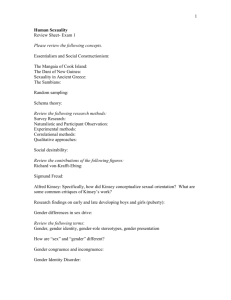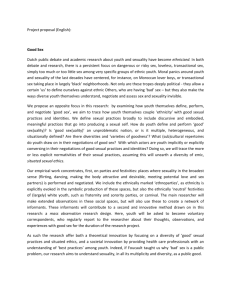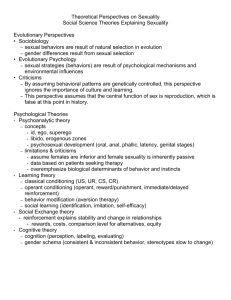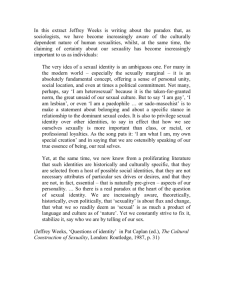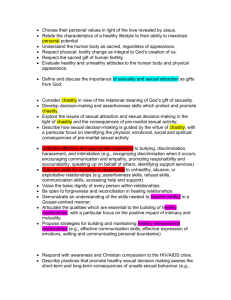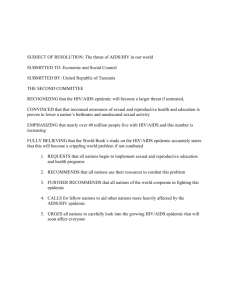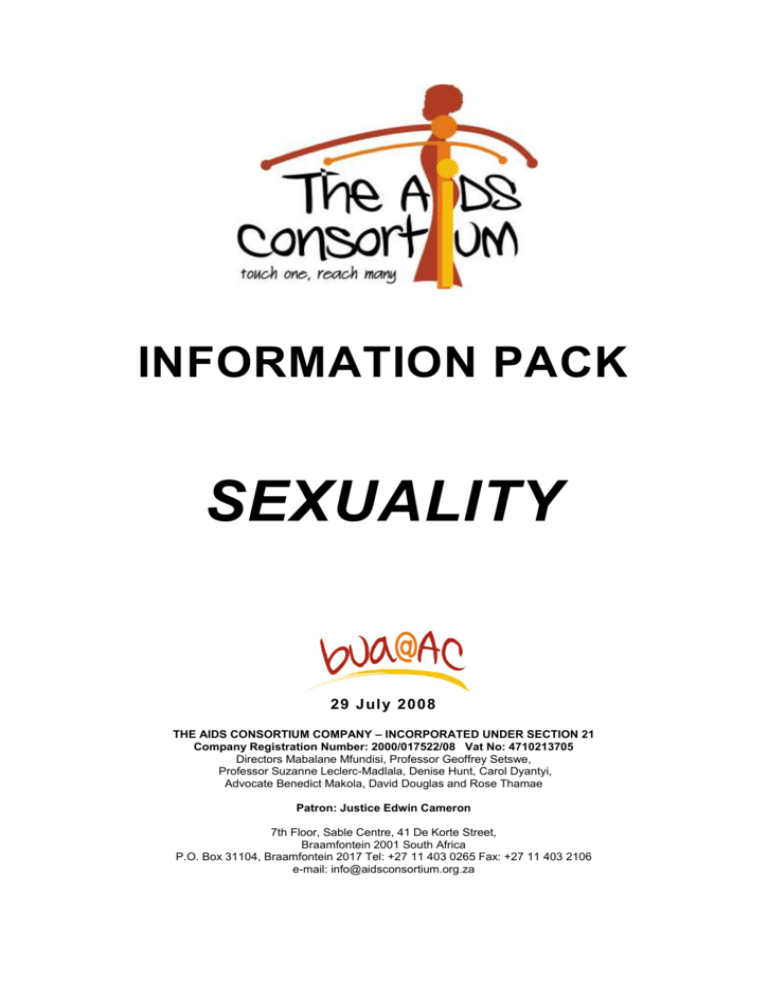
INFORMATION PACK
SEXUALITY
29 July 2008
THE AIDS CONSORTIUM COMPANY – INCORPORATED UNDER SECTION 21
Company Registration Number: 2000/017522/08 Vat No: 4710213705
Directors Mabalane Mfundisi, Professor Geoffrey Setswe,
Professor Suzanne Leclerc-Madlala, Denise Hunt, Carol Dyantyi,
Advocate Benedict Makola, David Douglas and Rose Thamae
Patron: Justice Edwin Cameron
7th Floor, Sable Centre, 41 De Korte Street,
Braamfontein 2001 South Africa
P.O. Box 31104, Braamfontein 2017 Tel: +27 11 403 0265 Fax: +27 11 403 2106
e-mail: info@aidsconsortium.org.za
Table of contents
1
SECTION A: AGENDA ______________________________ 3
2
SECTION B: SEXUALIT Y ____________________________ 4
2.1
Introduction ____________________________________ 4
2.2
What is sexuality ________________________________ 5
2.3
Gender in Sexuality ______________________________ 5
2.4
Diversity in sexuality _____________________________ 6
2.5
Culture, religion and sexuality _____________________ 6
2.6 Sexuality in relation to HIV and AIDS _______________
2.6.1 The risks involved in sexual activities _____________
2.6.2 Sexual risk chart ______________________________
2.6.3 Always Protect Yourself ________________________
2.6.4 Positive/ Negative Couples ______________________
2.6.5 Concurrent Sexual Partners _____________________
7
7
7
8
8
9
2.7 Sexual Health ___________________________________ 9
2.7.1 Unhealthy sexuality ___________________________ 10
2.8
Conclusion ____________________________________ 11
2.9 Resources on sexuality (available at the AIDS
Consortium Library) _________________________________ 12
2.10
References ___________________________________ 14
3
SECTION C: MINUTES O F THE MAY BUA SESSIO N _____ 15
4
SECTION D: ATTENDANC E REGISTER _______________ 19
2
1
SECTION A: Agenda
Bua@ AC Agenda
Date: Tuesda y, 03 June 2008
Time: 11h00 – 13h30
Venue: Museum Africa
New tow n
Chair: Gerard Payne
Theme: Sex and Sexuality
Scribes: Martha Legong & Ntokozo Shabalala
Outcomes:
Encourage people to embrace their sexuality
Talk openl y about sex
12:00
1
W elcome guests to the meeting
12:01 – 12:05
2
Tribute to people who have lost their lives to the
epidemic, and expression of solidarity in the fight
against AIDS, stigma and discrimination – 1 minute
silence
12:05 – 12:20
3
Apologies
Adoption of previous minutes
Introduction of all present: Let’s meet one another! –
W arm up
12:20 – 13:00
4
Introduction of panel and opening of discussion
13:00– 13:20
5
Sexual risk chart – Gerard Payne
13:20– 13:40
6
Soul City
13:40– 13:50
7
Launch of treatment literacy pamphlet – Gerard Payne
13:50-14:00
8
AC messages – Joseph Dithako
14:00 -14:20
9
Announcements by AC – Denise Hunt
New staff
AIDS Portal
AIDS Conference Hub
HIV scrutinize
VCT competition
14:20 – 14:25
13 Announcements from the floor
14:25 – 14:30
14 Vote of thanks – AIDS Consortium
Date of next meeting 26 August 2008 – possibly one day
conference feedback!
Community radio shows
3
2
2.1
SECTION B: Sexuality
Introduction
Sexuality is a natural and healthy part of l iving that begins
at birth and continues throughout life. There is a diversity of
values and belief s about sexuality, because of these
differences, sexual behaviours and tendencies can be
difficult to talk about. However, through an open and honest
conversation regarding sex and sexuality we can combat
misunderstandings and avoid health risks, particularly the
risk of transmitting HIV, the virus that leads to AIDS.
Taking into account differences in gender, sexual
preference, culture, and religion, thi s information pack will
look at the complex subject of sexuality. This information
pack will particularly focus on how HIV/AIDS fits into the
conversation about sex and sexuality.
4
2.2
What is sexuality
“As a human being, your sexuality i s a part of your physical,
emotional, intellectual, and social self. It affects how you think of
yourself and how you relate to others, as well as how they relate
to you, and it is a part of you throughout your entire life”.
(http://health.usnews.com )
Is sexuality about sex or is sex about sexuality?
Sexuality is not sex. Although it can include sex or sexual
relations, a person’s sexuality goes beyond these physical acts.
There are three components of sexuality: eroticism, gender and
reproduction. Sex is only the erotic component of sexuality.
2.3
Gender in Sexuality
In many societies women and men are expected to behave
differently. It is often considered taboo for women to explore their
sexuality while it is acce ptable for men to do so. At an early age,
girls are taught that it is ‘bad’ or ‘naughty’ to discuss things like
sexual fantasies, masturbation, orgasms or sexual pleasure. A
woman is considered promiscuous if she has more than one
sexual partner, however, multiple sexual partners for men is
’normal’ and, at times, equated with popularity. Other gender
norms and stereotypes about sexuality are:
W oman are not expected to have fulfilling sex lives; only
men are supposed to enjoy sex.
In many societies, a ‘go od woman’ is not supposed to
initiate sex and is not expected to have a great knowledge
about sex; men on the other hand, are expected to be
experienced and know about sex.
These stereotypes are often perpetuated by society and
encouraged by the media. This emphasis on so -called innocence
prevents young women from seeking information about sex or
facts relating to their sexual health. W hile common notions of
femininity promote ignorance, innocence, and virginity, dominant
versions of masculinity encourage young men to seek sexual
experience with a variety of partners. Stereotypical gender roles
place young women, and to a lesser extent young men, at
heightened risk of HIV infection. Biologically, the consequences
of sexual acts are more likely to effect fem ales. For example,
women can get pregnant, and have a higher chance of contracting
HIV.
The invention of contraceptive technologies has eliminated the
fear of pregnancy and greatly lowered the risk of transmitting
HIV/ AIDS, therefore enhancing sexual ple asure.
5
2.4
Diversity in sexuality
Sexuality also includes a diversity of sexual orientations.
The following are different types of sexual orientations:
Heterosexuals - People who are emotionally, physically
and sexually attracted to people of the opposit e sex e.g. a
man attracted to a woman and vice versa.
Lesbians - W omen who are emotionally, physically and
sexually attracted to other women.
Gays - Men who are emotionally, physically and sexually
attracted to other men.
Bisexuals - People who are emotio nally, physically and
sexually attracted to people of more than one gender e.g. a
man or woman attracted to both other men and women.
Transgender - People who do not act according to the
gender norms of their culture. This could mean that they
simply dress differently and may feel that they are neither
male nor female – or are both.
Different sexual orientation is an important part of people’s
sexuality and needs to be embraced.
2.5
Culture, religion and sexuality
How do a person’s culture and religion influ ence their sexuality?
In many cultures and in most religions, issues of sexuality are not
discussed. However, the silence surrounding sexuality has a big
influence on sexual relations. A very good example of religions
effect on sexual intercourse is the no tion that all forms of sexual
activity is limited to those who are married, making any
discussion of sex and sexuality, pertaining to unmarried persons,
unacceptable or taboo.
Another, more extreme, example of females having less power in
relation to the ir sexuality is the practice of female genital
mutilation or FGM.
FGM is the surgical removal of external
genitals or the clitoris. It is a very complex cultural practice in
some parts of Africa.
W omen are urged by their male
counterparts to undergo this surgery. Thus women are
discouraged from enjoying sexual relations or exploring their
sexuality fully.
Talking about sex or sexuality is not encouraged. It can be
especially difficult to discuss the matter between parents and
children. W hile conversation s about sexuality may be difficult or
even uncomfortable, it is important to have an age -appropriate
conversation, as it often helps the child realize that their sexuality
is not only alright, but normal.
6
2.6
Sexuality in relation to HIV and AIDS
As mentioned above, sex is part of a person’s sexuality. Sex, or
rather sexual intercourse, is also one of the ways of transmitting
HIV. It is really important to recognize the human right of people
to
have
sex,
while
helping
to
mitigate
the
risks.
In accordance to this, by talking about sexuality and how it
relates to HIV, following the safety precautions outlined in this
packet will greatly reduce the risk of HIV transmission.
2.6.1 The risks involved in sexual activities
Even without the presence of sexual disorder s and discomfort,
sex and sexual activities can have consequences especially
afterwards. They are often risks involved when one engages in
sexual activities; it is best if one is aware of the dangers and
risks involved especially with unprotected sex.
The following is a chart to show the different sexual activities as
well as the HIV, STI and chances of pregnancy involved in each.
2.6.2 Sexual risk chart
Sexual activity
Cyber sex
Masturbation
Toy sex
Oral sex on a man
Orgy (group sex)
Oral sex on a
woman
Anal sex
Penile-Vaginal Sex
Fisting
Fingering
Thigh Sex
Rimming
Breast sex
Telephone sex
Dipping
Dry sex (vaginal)
Kissing
HIV Risk
No risk
No risk
No risk
Low
High
Low
STI Risk
No risk
No risk
No risk
High
High
Low
Pregnancy
Not possible
Not possible
Not possible
Not possible
Possible
Not possible
High
High
Low
Low
Low
Low
Low
No risk
Low
High
No risk
No risk
High
High
No risk
No risk
No risk
Low
No risk
No risk
Low
High
No risk
No risk
Not possible
Possible
Not possible
Not possible
Possible
Not possible
Not possible
Not possible
Possible
Possible
Not possible
Not possible
Please note the risk(s) involved apply w hen a condom and in
some instances contraception is not used. With condom use,
the risk(s) decreases or diminishes.
7
2.6.3 Alw ays Protec t Yourself
Today the only protection against the risk of sexually transmitted
infections, including HIV, is male and female condoms. “Latex
condoms are protective for all types of sex if used properly and
they don't fail. HIV cannot penetrate, permeate or cha-cha-cha
through intact latex. No way. No how.” Dr. Robert Frascino
quoted
on
a
forum
on
Positive/Negative
relationships
(TheBody.com) so, it is essential to wear a condom EVERY TIME.
2.6.1 Both Positive
Even for couples where both individuals are HIV-positive,
unprotected sex carries major health risks. People infected with
HIV are more susceptible to sexually transmitted infections (STIs)
and there is the possibility of re -infecting a partner with a new or
drug-resistant strain of the virus.
2.6.4 Positive/ Negative Couples
There are many difficulties surrounding positive and negative
couples.
One is when to disclose your status. People have
different opinions about when is the best time to disclose.
Everyone needs to figure this out for themselves and what they
decide to do may vary depending on the situation. Here are a
number of things for you to consider on the topic:
1. Both before and after disclosure, it is important to make sure
that sex is protected.
2. Discussing HIV status is a 2 -way conversation. (Are you even
aware of their HIV status?) It is also a personal piece of
information that one has the right to keep private (if they so
choose) in certain circumstances. W hen and how the discussion
comes up is dependent on the situation and the intimacy and trust
between the people involved.
3. If you are uncomfortable not having it talked about, then why
not get it out in the open so that it doesn't have to bother you
anymore?
4. If someone is going to not want to be with you simply because
you are HIV+, is this the type of person you would want to be
with?
5. It is absolutely not true that nobody would have a relationship
with someone who is HIV+. Being HIV+ should not be something
one needs to be ashamed of.
6. It is true that the longer t hings go on, the more difficult it can
be to disclose. That is why most people do like to get it out
sooner, rather than later.
7. Keeping secrets in relationships, especially when it is about
something significant in one's life, does not make for good
intimacy. Telling lies is worse.
8
8. W hile some people choose to tell other people about their HIV
status immediately (such as on the first date), the more common
rule of thumb is: try to have the discussion after a certain amount
of trust is developed, but before the relationship goes on too
long. As you know from experience, the exact timing of this can
be a tricky thing.
9. If you want to discuss HIV, look for opportunities or perhaps
even the desire to discuss it, from things the other person says.
10. In the end, it may be that bringing it up in conversation may
be more about your need to have it be known than your partner's
need to know.
11. If the conversation does not go well, do not feel defeated or
be upset by your status. Take the conversation a s a learning
experience.
2.6.5 Concurrent Sexual Partners
According to a study done by CADRE, Johns Hopkins Health and
Education in South Africa (JHHESA), Johns Hopkins University
Center for Communications Programs in Baltimore, Health &
Development Africa (H DA)/Khomanani and Soul City in 2006, it
was found that concurrent partnerships (having more than one
partner at a time) was common in South Africa. This showed
concurrent sexual partnerships as one way of fuelling the HIV and
AIDS epidemic as some of the p eople involved in the study
admitted to not using condoms all the time while engaging in sex.
The study also showed that having mutliple sexual partners was
regarded as normal for these young adults and they felt that it
was almost impossible to stick to one partner. This study showed
one important component of sexuality and sexual behavior in
South Africa.
2.7
Sexual Health
A healthy sexuality is always encouraged, especially when it
comes to sexual intercourse. Healthy sex does not just mean the
absence of disease but it means engaging in sexual activities
without any force, coercion, pressure or guilt. Healthy sex is
when both partners are aware of what they are doing, are willing
and are responsible for what they are doing. Sadly this is not
always the case in relationships or sexual engagements.
Educating both men and women about the hazards of unhealthy
sex is essential because everybody has rights to sexual and
reproductive health. Discussing Issues of sexual violence,
Stigma, self -esteem and HIV enabl es people to have a better
understanding of their sexuality, making sex less taboo.
Sexual health includes discussing the following things:
Sexual myths
9
Safe sex practices, (including wearing condoms and birth
control methods) and risks involved in sexual activities
Sexual problems and complaints like early ejaculation or
painful sex.
2.7.1 Unhealthy sexuality
Sometimes sexuality is used to harm others. W ays in which this
can happen are the following:
Forcing someone to have sex with you, this can be done
through rape, sodomy and or incest
Sexual assault of any form
Sexual harassment
Any form of sexual coersion
2.7.1.1 Sexual Disorders
A sexual disorder is any disorder involving sexual functioning,
desire, or performance.
(http://medicaldictionary.thefreedictionary.com/disorder )
Many people suffer from sexual disorders.
A sexual disorder can be treated by medication and or with
therapy. Examples of common sexual disorders:
Male erectile disorder – Inability to have an erection or to
maintain one
Premature ejaculation – Ejaculation happening either
before penetration or soon after penetration.
Orgasmic disorder (male or female)– A delay or inability to
reach climax
Vaginismus - An involuntary or persistent spasm of the
muscles causing penetration to either be very painful or not
to be possible.
Hypoactive Sexual Desire Disorder – Decreased or absent
sexual desire.
Paraphilias include fantasies, behaviours, or sexual urges
focusing on unusual objects, activities, or situations.
Examples of some of these are paraphilias include:
o Necrophilia - Urge to want to have sexual activities
with corpses.
o Paedophilia - (Urge or fantasy to want to have sex
with children).
o Exhibitionism - exposure of genitals to strangers.
o Voyeurism - Fantasy and or urges of wanting to watch
others engaging in sexual activities often without them
knowing or wanting.
o Fetishism – Sexual urges and behaviour, which is,
associated with non -living objects e.g shoes.
10
o Zoophilia - Fantasy about wanting to have sexual
activities with animal corpses.
Sexual disorders can cause a great deal to discomfort to the
sufferer and to others. If one suffers from any of the above,
he/she should seek treatment.
2.8
Conclusion
As we have discovered, a person’s sexuality is not only sexual
relations or gender, but there are many factors involved.
A
person’s family, culture and religion often influence their
sexuality. W hen trying to wade through all of these differences, it
is important to stay in touch with how you feel, as a sexual being.
Though learning more about our own bodies and sexual
pleasures, we can understand and know how to prevent sexually
transmitted infections; expressing sexuality is healthy and natural
as long as both people remain open and honest about their
bodies and protect themselves.
11
2.9
Resources on sexuality (available at the AIDS Consortium Library)
Please note that all this books are accessible from the AIDS
Consortium Library. One can borrow the books for two weeks then
return them or you can ask for an extension (more time) if you are
not finished with a book.
If you are interested in borrowing any of the resources featured
here and others, contact the librarian (Martha) on 011 403 0265
or martha@aidsconsortium.org,za
The service is free of charge.
Title: Spreading the word
Author: SAFAIDS (Compiler)
Summary: This DVD tells the story of African women who were
inspired by the ‘vagina mono logues’. It reveals themes about
gender-based violence, sexual and reproductive rights and
women’s vulnerability to HIV infection.
Title: The gay 100
Author: Russell, Paul
Summary: This book is about the ranking of the most influential
gay men and lesbian women of the past and present from rock
Hudson to Virginia W oolf. It also affirms that gay men and lesbian
women have been part of history from ancient times through to
the present day.
Title: Virgin sex for guys: a no -regrets guide to safe and healthy
sex
Author: Luadzers, D
Summary: It addresses doubts that even guys have about
engaging
in
sexual
activities
and
also
teaches
them
consequences of having sex and how to have sex without getting
hurt.
Title: The sex secrets: bodyworkz revealed
Author: Orr, N & Patient
Summary: This is a guide for sexuality for young adults. It covers
issues such as changes that happens in the body as boys and
girls grow up and sexual reproductive health.
12
Title: My feelings, myself: a growing up guide for gi rls
Author: Madaras, L & Madaras, A
Summary: This book answers questions teenagers often ask
about feelings, growing up, how to say no and other hard to find
information on sexuality.
Title: Re-thinking sexualities in Africa
Author: Arnfred, S (ed.)
Summary: This publication investigates sexuality in Africa while
also creating space for alternative approaches. Issues such as
female genital mutilation and feminist engagement in HIV/AIDS
are discussed.
Title: Sexually Transmitted Diseases
Author: Russell, Paul
Summary: W ritten by a physician, this book is a complete up -todate guide to safer sex practices, testing protocols, symptoms
and treatments of over twenty sexually transmitted diseases from
herpes to HIV.
Title: The complete guide to safer sex
Author: Russell, Paul
Summary: This book provides the answers to sexual questions. It
is the most informative and effective tool about protecting one
from STIs and HIV infection.
Title: Virgin sex for girls: a no -regrets guide to safe and healthy
sex
Author: Luadzers, D
Summary: This book is a girl’s guide to safe and healthy sex. It
features real life stories from teenagers and adults about their
first sexual experiences including the physical, emotional, and
social consequences of having and (not having) s ex.
Title: Questions kids ask about sex
Author: Russell, Paul
Summary: This book answers questions that children ask about
sex and other sexuality issues. It enables one to starts
conversations with his/hers kids.
Happy reading!
13
2.10 References
1. Sexuality. [Online]. Available at: http://sexuality.about.com/ .
Assessed 08 July 2008
2. Warren Parker et al. 2007. Concurrent sexual partnerships
among young adults in South Africa: challenges for HIV
prevention communication. CADRE. Johannesburg.
3. Victor, J.S. 1980. Human sexuality: a soci al psychological
approach. Prentice Hall. New Jersey.
4. The AIDS Consortium. How do I perpetuate gender norms
and stereotypes?
5. Green,
B.
Sexual
Disorders.
Available
http://priory.com/sex.htm . Assessed on 15 July 2008
at:
14
3
SECTION C: Minutes of the Ma y BUA session
Background and disclaimer
Bua is a Sotho word meaning, “talk”; it was commonly used at
activists’ meetings in the apartheid struggle. W hen one was
making a valid point and the supporters wanted to sup port his/her
statement, they would just say “Bua”, which encouraged freedom
of expression. These sessions also encouraged networking,
comradeship and skills transfer. This epitomises the AC monthly
meetings, hence – bua@AC.
The AIDS Consortium Bua session s stand out as a pioneering
initiative, bringing together over 100 HIV and AIDS and human
rights activists monthly to discuss topical issues, hence a
different theme each month. These have taken place for 16 years
and are thus renowned in the sector.
The objectives of these Bua sessions include, but are not limited
to:
Networking and community profiling platform for affiliates
Forum to promote discussion and debate on topical and
controversial themes, driven by the affiliate body.
Skills transfer and sharing the latest HIV and AIDS information
through researched information presented at each meeting in an
information pack
Mechanism to share community news and events
A place to express views, which can influence strategy at local,
provincial and
national level.
Our mandate is therefore to stimulate debate and controversy, so
that together we can eradicate confusing messages, myths and
beliefs that continue to drive incidence, human rights violations
and stigma and discrimination. All views are ther efore heard,
debated and captured.
Please note therefore, that the views expressed in these minutes
do not necessarily reflect those of The AIDS Consortium.
Please feel free to engage with the AC team for further clarity on
any topical information.
Further information is available through our Resource Centre
(library, distribution, and cyber café)
15
Gauteng bua@ AC Minutes
Date: Tuesda y, 24 June
Time: 12h00 – 14h30
Venue: Museum Africa
New tow n
Chair: Joseph Dithako
Apologies
Mme Linda from Zenze le sent a message that she might be a bit
late.
ADOPTION OF PREVIOUS MINUTES AND CORRECTIONS
Tshepo from Themba moved for adoption of minutes as a true
reflection of April bua@AC, and there were no corrections.
Introduction of theme and w hy – link to w hat NSP sa ys about
children: Denise Hunt
She opened by thanking everybody for a job well done in the
interest of the children and for being children lovers and
encouraged everyone to embrace childhood by encouraging
children to be children. She then pre sented stats on HIV and
children, and that the NSP aims to achieve its aims around
children by teaching children's rights, addressing cultural barriers
and encourage that HIV positive children to be put on treatment
as soon as the need arises. She also emp hasised that mothers to
HIV positive children should not delay accessing treatment
because keeping the mother alive has an impact on the child's
mortality.
She then requested NGOs to submit their reports and stats to
inform the SANAC presentation at the plenary meeting on 31 July.
She closed by encouraging NGOs to request NSP copies from
AIDS Consortium through Bongani.
Profile: parent caring for HIV positive child: Audrey Atherton
Audrey spoke of their programme in Hebron outside Pretoria and
highlighted the challenges of not accessing formula milk for
16
children born to HIV positive mothers, raising HIV positive babies
and emphasised that not all children born HIV positive are born
sick and weak. She elaborated on the importance and
effectiveness of A RTs in children and closed with a presentation
on one of their children who was born HIV positive and has
recovered due to ARTs which he had been taking for five (5)
years now (please see presentation attached).
Services available for children living wit h HIV: Lauren de Kock
from ECHO
Invited people to utilise Echo’s services for HIV positive children.
The services offered include: ARTs, psychosocial support and
food parcels. She also mentioned that they conduct research on
body composition, TB and HIV and children on HIV, she
highlighted that all their services are free and invited the public to
take advantage of their availability.
Profile: parent lost child to HIV and taking care of orphan:
Mam Sarah from Nanga Vhutshilo
Opened with a hymn and c ongratulated The AIDS Consortium for
using ordinary people in their posters. She shared her experience
of losing a daughter due to AIDS and the emotional distress of
discovering that her grand child is also HIV positive, challenges
of dealing with stigma d ue to caring for an infected child. She
also emphasised that HIV positive children are not disabled and
that they can function and thrive like any other child provided
they are raised properly in a loving and caring family.
Adoption procedures and stats: Rose Mnisi (Dept. of Social
Development)
Presented on the criteria, principles and process of adoption in
S.A she also mentioned that the country is in crisis levels
regarding to OVC's due to teenage pregnancy, poverty and
parents mortality due HIV. She pleaded with the participants to
consider adoption since there are more orphans than people who
are adopting; she also invited NGOs to form partnership with the
government to reduce the high numbers of OVCs. She finished
her presentation by showing the st ats on adoption since 2003.
Please see presentation attached.
Profile: person w ho has adopted a child: Pastor Elizabeth
An adoptive mother of six with only two being on grants spoke on
the challenges she faces and the importance of loving and being
patient with adopted children.
17
Soccer pla yer’s personal experience w ith HIV : Fabian
McCarthy
Spoke of his experience of losing two friends due to HIV and
made a call to end stigma and discrimination to those living with
HIV
and
encouraged
openness and
communication
among children living with HIV.
Messaging
Rhulani led the messaging process.
Two messages for the month:
Message 1: I have the right to be a child
The premise for this message was derived from the situations in
which children find thems elves in these days – children heading
households, etc. Children have the right to be children, to play, to
health, education etc. which are becoming more and more difficult
to achieve in this HIV and AIDS era.
Message 2: HIV and children statistics
This poster is meant to raise awareness of the impact HIV has on
children in the society
Rhulani thanked Nanga Vutshilo (one of AC’s affiliates) who
helped organise the children posing for the posters. She also
acknowledged them for helping with organising a children’s
workshop prior this meeting. She encouraged the meeting to visit
the exhibition outside to have a look at some of the stories written
by children at the workshop.
Profile: Child heading a household Celiw e from IkagengItireleng AIDS ministri es
Celiwe shared her experience of losing her parents and brother
due to HIV, the pain, anger frustration and stress she had to go
through. She ended on a positive note of telling how she
overcame the situation and ended up adopting other children
orphaned by HIV.
Acknowledgements of partnerships – Tebogo from the South
African Football Players Union (SAFPU)
Tebogo introduced his team made up of SAFPU staff and union
members who are soccer players. He asked them to stand so that
the meeting could ack nowledge them. He spoke about the
partnership between AC and SAFPU and pledged SAFPU's
commitment to fighting HIV.
Denise and Rhulani thanked everybody for attending and handed
out AC t-shirts to all speakers.
Meeting was adjourned at 14h30
18
4
SECTION D: Attendance Register
Gauteng Bua Attendance Register
Date: Tuesda y, 24 June 2008
Time: 12H00 – 14h30
Venue: Museum Africa
New tow n
Adults
No.
Name & Surname
Organisation
1.
Bernard Fillis
Fighting AIDS Together
2.
Lynn Fortwin
Fighting AIDS Toget her
3.
Rick W ykes
Fighting AIDS Together
4.
Ricardo Martin
Fighting AIDS Together
5.
Darius Prince
EPW F
6.
Monic Kok
EPW F
7.
Abeda Davis
EPW F
8.
Zukiswa Mbuge
Infected &Affected
9.
Maria Lande
Infected & Affected
10.
Linda Mkhwebane
Qalakabusha HBC
11.
Anthony Richard
GIEP
12.
Thembi Zwane
Philani Support Group
13.
Happy Zimu
Philani Support Group
14.
Maggie Hadebe
Mary’s Community Centre
15.
Jabu Khoza
Reisumi Impumelelo
16.
Quinton Mokoena
SCGN
19
17.
Grazell Dejages
PUSH
18.
Susan W illiams
PUSH
19.
Mariam Mohlala
Siphesihle
20.
Nhlanhla Zwane
Entokozweni
21.
Patricia Msomi
Bonisiwe FF
22.
Morebane Mathabang
Nanga Vhutshilo
23.
Fikile Mtshali
St Mary’s
24.
Lucy Palane
MCC
25.
Gloria Khorombi
Takalani Creative Protection
26.
Ruth Markos
Sedibeng SCP
27.
Kolobe Nthabi
Siphesihle
28.
Mohammed
Emmanuel
29.
Fundie
Emmanuel
30.
Patience Mtonga
Little Flowers
31.
Boitumelo Bapela
Mary Community Centre
32.
Favourite Mbatha
Ikusasa Lethu
33.
Yoliswa Sofa
Ikusasa Lethu
34.
Eunice Mpongo
Ikusasa Lethu
35.
Thuli Zwane
Uncodolwethu
36.
Tshidiso Phafuli
True W itness
37.
Miriam Ndebele
Cotlands
38.
Itumeleng Phanuel
Mookodi
39.
Poppy Themba
Thalithakumi
40.
Bongiwe Hlongwane
Thalithakumi
41.
Ricardo Martin
Fighting AIDS Together
42.
Brett Leon
Fighting AIDS Together
43.
Paul Moeketsi
Mookodi
44.
Boitumelo
SABC Ne ws
45.
M. Pule
Bojanala Media
46.
Nwabisa Ngukon
Media
47.
Given Nkone
Qalakabusha
48.
Lauren de Kock
ECHO
20
49.
Fikile Dube
ECHO
50.
John
GALA
51.
Thando
AMHO
52.
Tshepo Letsoalo
Themba HIV/AIDS Organisation
53.
Sarah Mahlangu
Ndlovu AIDS awareness
Program
54.
Nthabiseng Mthwethwa
Ndlovu AIDS Awareness
Program
55.
Elias Molokomme
Tshifhiwa HBC
56.
Glen Mama G Mabuza
HIVSA
57.
Phillip Mthethwa
Tsogasa Comm.Project
58.
Zandile Mchunu
Qalakabusha HBC
59.
Joyce
KACP
60.
Evelyn
DAM
61.
Maggie Mathenjwa
Humana People to People
62.
Simon Mabuza
Philani Support
63.
Mokho
NGO
64.
George
LCOD
65.
Hilda Rasebeka
Uncedolwabantu
66.
Harriet Dladla
Clean Touch
67.
Gloria
Humana People to People
68.
Mapule Matjila
Friends for Hope
69.
Nonhlanhla Nzima
Friends for Hope
70.
Portia Khumalo
Ipholoseng
71.
Angel Mbatha
Ipholoseng
72.
Molefe Nthabiseng
Bantubebambanani
73.
Mpho Molebatsi
Uncedo
74.
Kagiso Kekana
Battle Aids Project
75.
Themba Grammony
Uncedolwabantu Health
Provider
76.
Carol Mabiletsa
Afrika Vuka Foundation
&Training
21
77.
Elsi Sithebe
Helping Hand
78.
Veronica Makitla
OVC HBC
79.
Selinah Madihlaba
Ndlovu AIDS Awareness
Program
80.
Loraine Koapa
Lethithemba
81.
Agbeline
Lethithemba
82.
Annette Bronkensha
Childline Gauteng
83.
Hellen Mokoena
Ndlovu AIDS Awareness
Program
84.
Isaac ‘Shakes’ Mafanela
Youth In Action
85.
W onda Mahlangu
NAAP
86.
Lerato Letsoso
Chelah Trading and Projects
87.
Bekithemba Ndlovu
In Vivo Health Care
88.
Solly Matile
AC
89.
Martha Legong
AC
90.
Hopolang Mothibeli
AC
91.
Petunia Mothogo
Amazon
92.
Khothatso Tshabalala
Medical Trust
93.
May Makhoro
IACG
94.
Sindi Solopi
CARE
95.
Anthony Bouwers
CARE
96.
Alice Maqachela
Sakhi-Sizwe
97.
Molebogo Modutwane
Tsebo Ke Matla
98.
Roy Naidoo
AC
99.
Ntokozo Shabalala
AC
100. Dineo Kobela
Luthando PHC
101. Simphiwe Mohomane
Open Disclosure Foundation
102. Masingita Lamban e
Ndlovu Medical Trust
103. Martha Luka
SASSA
104. Fumane Motloung
SASSA
105. Laura Lopez Gonzalez
Plus News
106. Rundey
Little Angels House
22
107. Charne Atlerton
T. EAM Survival Storehouse
108. Ndomu
CARE
109. Daphne Zwane
Zimisele
110. Valencia Molisa
Sakhi-Sizwe
111. Eddie Dinha
SAFPU
112. Thandi Mzinyane
Jabavu Tholimpilo
113. Nokuthula Mfaku
AC
114. Phumza Moeletsi
Muslim AIDS Programme
115. Victor Sibeko
W ide Horizon Hospice
116. T. Ncombo
MCDP
117. Mamsie Mngomesulu
Sakhi-sizwe
118. Tshedi Mabaleka
Somelele HIV&AIDS
119. Hontiswa
Somelele HIV/AIDS
120. Vusi Msiza
Bophelo
121. Pastor Mamba
Mission
122. Teboho Moroane
Lukhanyo
123. Aabeda Sithole
MAP
124. Eunice Mabaso
Siyakhula Children
125. Ntswaki Moronshe
Sizanani Comm. Dev Project
126. Sophie Masina
Greater Alberton HBC
127. Daniel Opara
Individual
128. Oupa Mothilene
AC (NW )
129. Bheki Mkhize Selina
CUSHIAN
130. Germinah Makhetha
Iothaso
131. Boy Mabeta
Mo-Afrika Itlhokomele
132. S. Moni
Individual
133. Nokuthula Khoza
Senzeni
134. Zukiswa Maqubela
Senzeni
135. Babalwa Maqubela
Senzeni
136. Tebogo Boaosi
Diepkloof Forum
137. Annastasia Sibeko
SHBCG
138. Lerato Khaole
Goyapele Communications
23
139. Carol Dyantyi
Ikageng
140. Promise Kambula
Ikageng
141. Sibongile Mazibuko
Nanga Vhutshilo
142. Bruce Ngwenya
HAPYD
143. Celiwe Mtshixa
Ikageng
144. Gift Malapane
Ikemeleng HIV/AIDS Project
Development
145. Super Mtshali
Mo-Afrika Itlhokomele
146. Yngve Sjolund
CD4 Magazine
147. Busisiwe Rooi
Busisiwe
148.
Tsogang Community Project
Tokoloho Monareng
149. Sandra Ncube
Red Peg (pty) ltd
150. T. Maqungy
Gugulethu
151. Joseph Didisha
Mo-Afrika Ithlokomele
152. Agnes
Lotsha
153. Kgopotso Tiwagadi
Let us Grow
154. Tshepo Mokgosi
Grow Bacha
155. Mbizo Moshokwa
Deep 6 Records
156. Amos Mkhabela
Philani
157. Tryphine Sasa
Philani
24
Gauteng Bua Attendance Register
Date: Tuesda y, 24 June 2008
Time: 12H00 – 14h30
Venue: Museum Africa
New tow n
Children
No.
Name & Surname
Organisation
148.
Moeketse Setholoho
P.U.S.H
149.
Ronaldo Klaasen
P.U.S.H.
150.
David Van de Merwe
P.U.S.H.
151.
Lechesa Tefo
P.U.S.H.
152.
Sephesithe Kidibo
P.U.S.H.
153.
Zandile
Immanuel
154.
W endy
Immanuel
155.
Galaletsang
Immanuel
156.
Mthokozisi Moseko
Siphesihle HBC
157.
Kamohela Mohitswane
Siphesihle HBC
158.
Mathapelo Mokoena
Siphesihle HBC
159.
Mihlali Mfaku
Nokuthula
160.
Somila Mfaku
Nokuthula
161.
Bontle Tolo
Entokozweni
162.
Kgomotso Lieu
Entokozweni
163.
Refilwe Matlaku
Entokozweni
164.
Sabelo Hlatswayo
True W itness Community
Project
165.
Mcebisi Khumalo
Ikusasa Lethu
25
166.
Aziphelli Ntofile
Ikusasa Lethu
167.
Kamohelo Morapedi
Ikusasa Lethu
168.
John Mnguni
Ikusasa Lethu
169.
Innocent Baloyi
Ikusasa Lethu
170.
Mafusi Robadala
Ikusasa Lethu
171.
Noluthando Madonsela
Ikusasa Lethu
172.
Bong’kosi Masinga
Ikusasa Lethu
173.
Sibulelo Shumelo
Ikusasa Lethu
174.
Musa Mbhele
Ikusasa Lethu
175.
Ntshese Moloi
Nanga Vhutshilo
176.
Babalwa Maqubela
Senzeni Support Group
177.
Iris Mokheledi
Nanga Vhutshilo
178.
Thato Ngobese
Nanga Vhutshilo
179.
Mpho Mokgajane
Nanga Vhutshilo
180.
Relebogole Matsebatlela
Nanga Vhutshilo
181.
Chiloane Humphey
Nanga Vhutshilo
182.
Maleke W endy
Nanga Vhutshilo
183.
Dipholo Karabo
Nanga Vhutshilo
184.
Maphuko Caroline
Nanga Vhutshilo
185.
Mkhize Hildagis
Nanga Vhutshilo
186.
Baloi Nouhlauhla
Nanga Vhutshilo
187.
Irene Rakawu
Afrika Vuka
188.
Lebo Mabiletsa
Afrika Vuka
189.
Tisetso Mabiletsa
Afrika Vuka
190.
Koketso Modisane
Afrika Vuka
191.
Naledi Kek
P.U.S.H
192.
Celestine Bulck
P.U.S.H
193.
Sikholiwe Hlatswa yo
P.U.S.H
194.
Tshepiso Raseboku
P.U.S.H.
195.
Alice Motete
P.U.S.H
196.
Gordon Bell
E.P.W .F
197.
Letichia Snyman
E.P.W .F
26
198.
Ash-Leigh Dicken
E.P.W .F
199.
Tshepiso Raradi
Little Flower
200.
Brenda Lenganya
Little Flower
201.
Mothatso Lenganya
Little Flower
202.
Tebogo Pule
Little Flower
203.
Londeka Sibisi
Thalithakumi
204.
Sinenhlanhla Ndlovu
Thalithakumi
205.
Slindili Maseko
Thalithakumi
206.
Marryjane Makhafola
Sedibeng Sa Bophelo
207.
Mpho Molefe
Sedibeng Sa Bophelo
208.
Bobo Mafanela
Youth in Action
209.
Moeketsi Rakale
Youth in Action
210.
Thabang Tsotetsi
Youth in Action
211.
Maphile Mofanela
Youth in Action Centre
27

